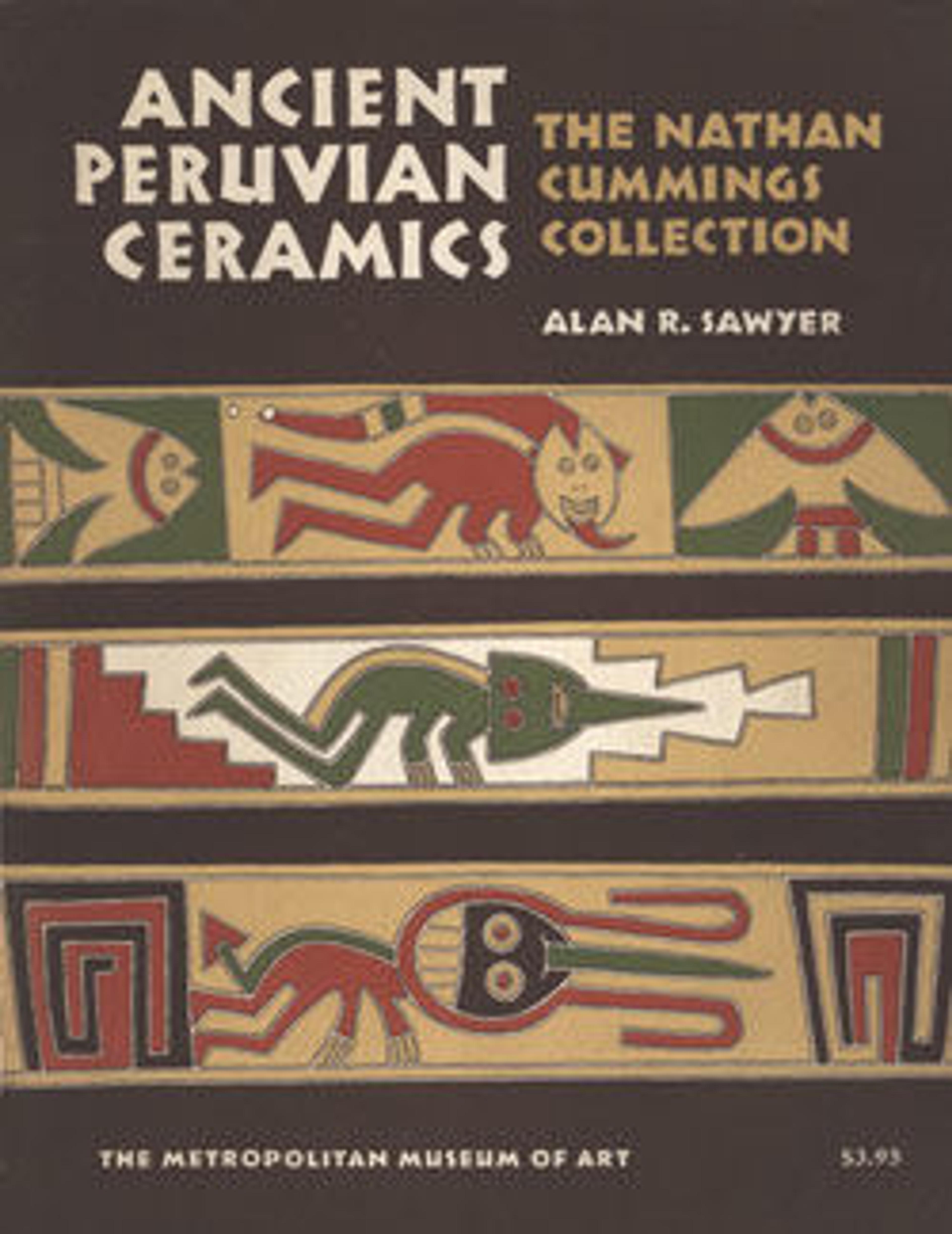Double-chambered bottle with effigy figures
This figure of a female holding up a small child may be part of a family group with MMA 66.30.4. Vicús ceramics are characterized by their orange ware enhanced with resist painting in black and post-fire painting in white. To achieve the resist negative design, the composition was outlined with a watery paint that acted as a resist after the vessel was initially burnished and fired. Then, the ceramic was fired again at a low temperature, causing the smoke to fill the uncovered surfaces. Finally, the resist was removed, revealing the brighter layer below.
This type of double chambered vessel has a whistle in the larger figure’s head. When liquid moves from one chamber to the other through the tube connecting the two chambers in forces air through the whistle to create a bird-like twittering sound. This can also be achieved by blowing into the spout.
The Vicús culture was contemporary with the larger Moche civilization (farther south on Peru’s coast) and was eventually incorporated into their orbit. The double-chambered shape of the Vicús bottles likely originated farther north, in what is now Ecuador.
References and Further Reading
Ikehara, Hugo. "La colección vicús en el Museo Central." Revista Moneda 193 (2023), pp. 56-63.
Kaulicke, Peter. “The Vicús-Mochica Relationship.” In Andean Archaeology III, edited by William H. Isbell and Helene H. Silverman, pp. 85-111. Boston: Springer, 2006.
Makowski, Krzysztof, Christopher B. Donnan, Ivan Amaro Bullon, Luis Jaime Castillo, Magdalena Diez Canseco, Otto Elespuro Revoredo, and Juan A. Murro Mena. Vicús. Colección arte y tesoros del Perú. Lima: Banco de Crédito, Perú, 1994.
This type of double chambered vessel has a whistle in the larger figure’s head. When liquid moves from one chamber to the other through the tube connecting the two chambers in forces air through the whistle to create a bird-like twittering sound. This can also be achieved by blowing into the spout.
The Vicús culture was contemporary with the larger Moche civilization (farther south on Peru’s coast) and was eventually incorporated into their orbit. The double-chambered shape of the Vicús bottles likely originated farther north, in what is now Ecuador.
References and Further Reading
Ikehara, Hugo. "La colección vicús en el Museo Central." Revista Moneda 193 (2023), pp. 56-63.
Kaulicke, Peter. “The Vicús-Mochica Relationship.” In Andean Archaeology III, edited by William H. Isbell and Helene H. Silverman, pp. 85-111. Boston: Springer, 2006.
Makowski, Krzysztof, Christopher B. Donnan, Ivan Amaro Bullon, Luis Jaime Castillo, Magdalena Diez Canseco, Otto Elespuro Revoredo, and Juan A. Murro Mena. Vicús. Colección arte y tesoros del Perú. Lima: Banco de Crédito, Perú, 1994.
Artwork Details
- Title: Double-chambered bottle with effigy figures
- Artist: Vicús artist(s)
- Date: 100 BCE–500 CE
- Geography: Peru, Piura
- Culture: Vicús
- Medium: Ceramic, pigment
- Dimensions: H. 8 3/8 × W. 4 × D. 11 1/4 in. (21.3 × 10.2 × 28.6 cm)
- Classification: Ceramics-Containers
- Credit Line: Gift of Nathan Cummings, 1966
- Object Number: 66.30.3
- Curatorial Department: The Michael C. Rockefeller Wing
More Artwork
Research Resources
The Met provides unparalleled resources for research and welcomes an international community of students and scholars. The Met's Open Access API is where creators and researchers can connect to the The Met collection. Open Access data and public domain images are available for unrestricted commercial and noncommercial use without permission or fee.
To request images under copyright and other restrictions, please use this Image Request form.
Feedback
We continue to research and examine historical and cultural context for objects in The Met collection. If you have comments or questions about this object record, please contact us using the form below. The Museum looks forward to receiving your comments.
